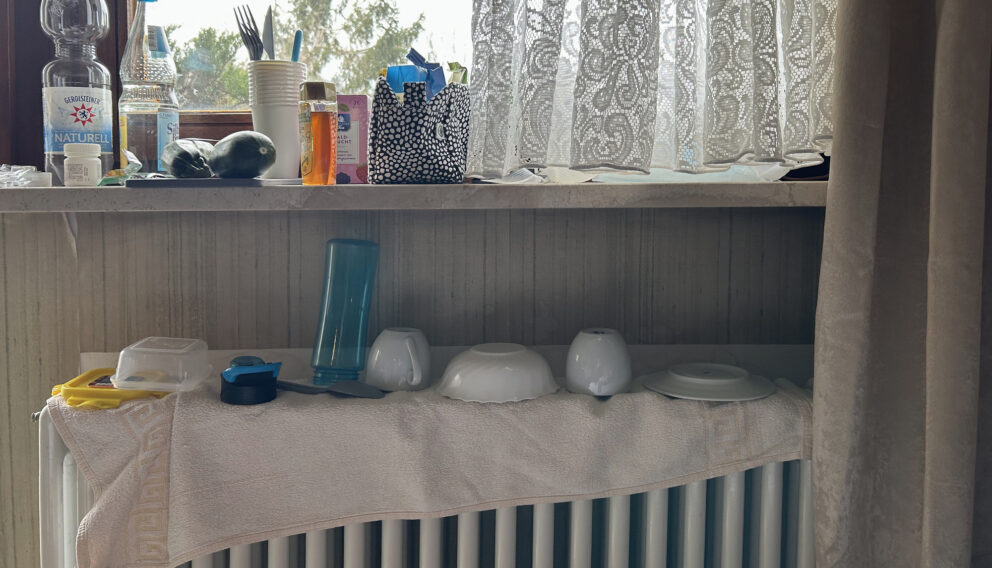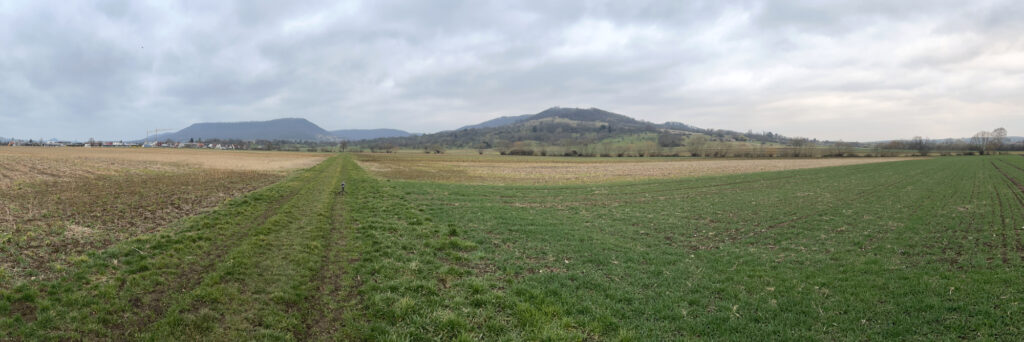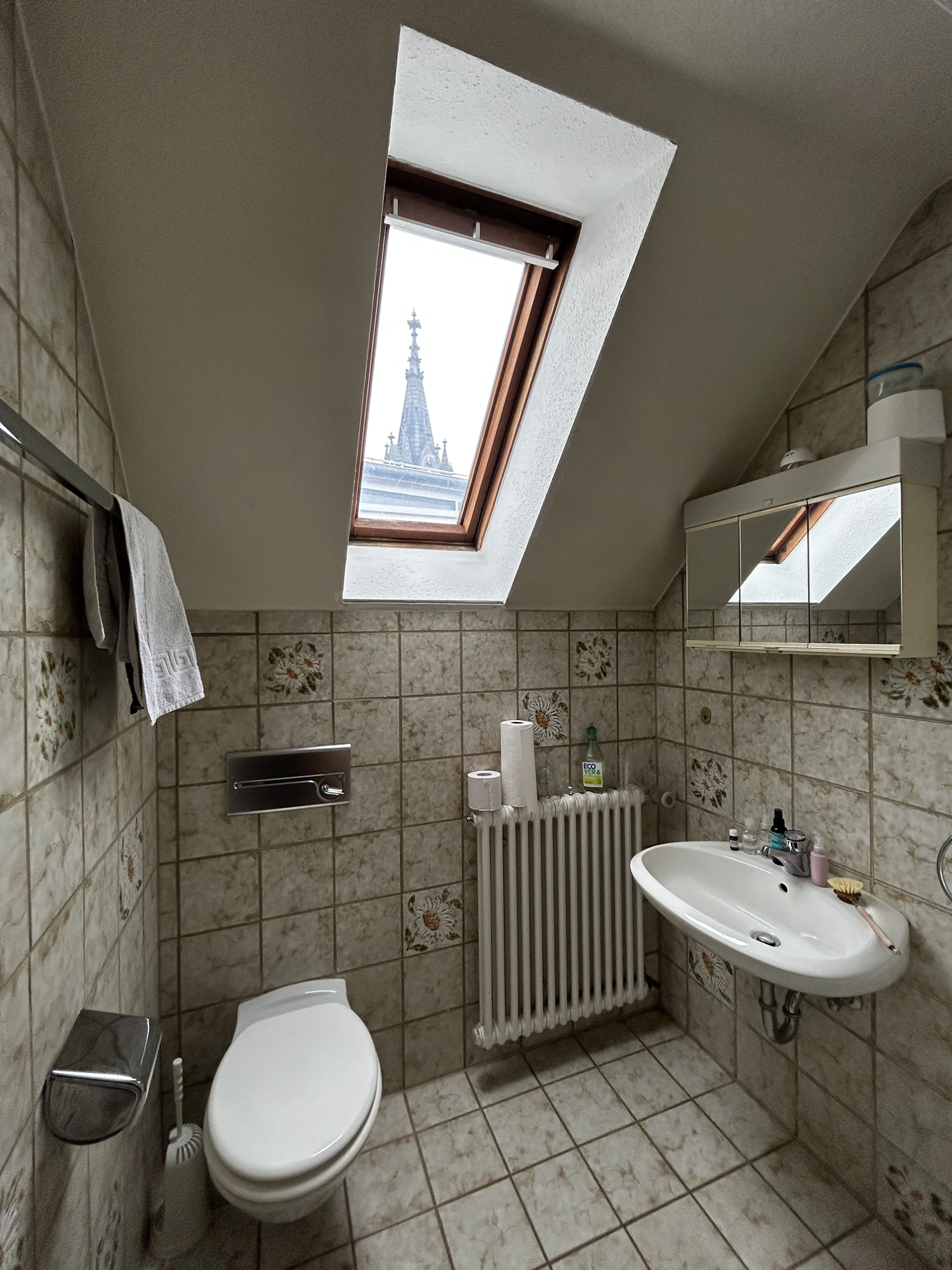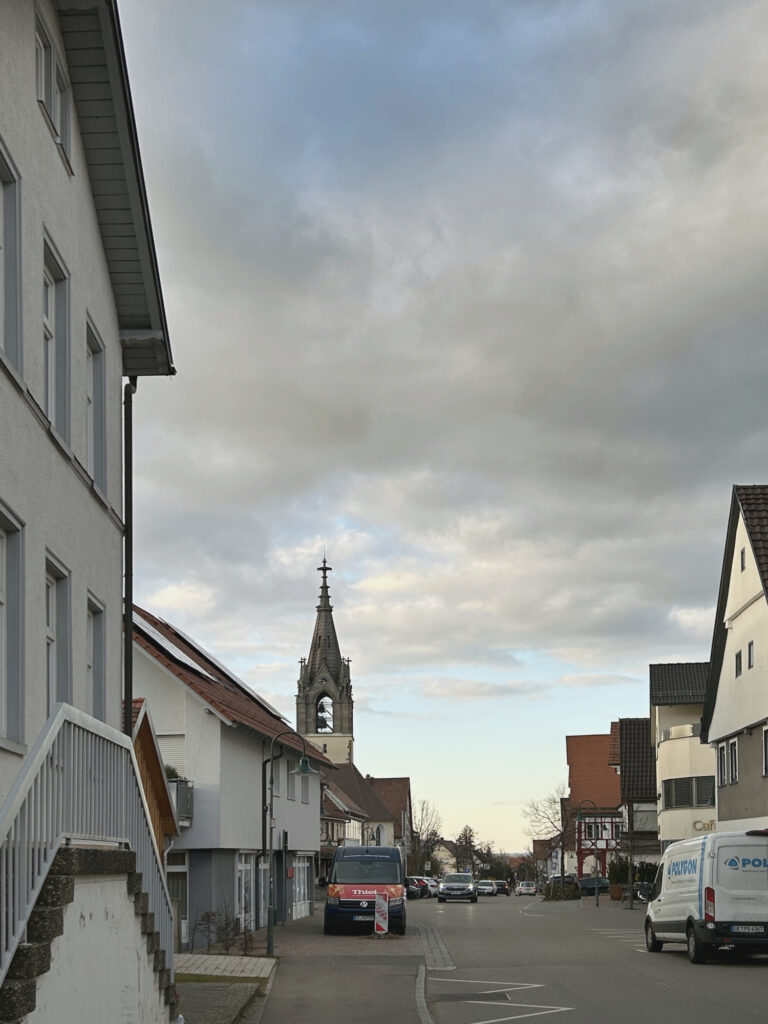Illness, Isolation, and Perceptions of Bells in Bissingen

Text & photos: Anne Tarvainen
What does it mean to experience a place from a single point of listening? During a field trip to Bissingen, Germany, illness confined me to my room — and offered an unexpected perspective on church bells, isolation, and the fragile rhythms of time. This personal reflection explores how soundscapes are not only heard but embodied, manifesting through the listener’s states of body-mind and creating shifting relations to community and place.
During our previous field trip to Skruv, Sweden, I found myself watching chickens in a garden outside the kitchen window, wondering what it might feel like to be rooted in one place and perceive the soundscape solely from that fixed position — like chickens in a coop. I received an answer to that musing during our next trip — though not in the way I would have wished.
Two days after our arrival in Bissingen, I fell ill and was essentially confined to our accommodation for seven days. As a result, my experience of “fieldwork” ended up taking place from a single listening position — my room — rather than unfolding as originally planned.
Before falling ill, I had one day of fieldwork. Together with my colleague Meri Kytö, I walked from Bissingen’s church (Marienkirche) toward the neighboring village of Nabern, stopping every fifteen minutes to record the tolling of the church bells. The wind was strong that day, and we quickly noticed how significantly it affected the reach of the bell sounds (cf. Trikootam and Hornikx 2019). Later that evening, I retraced our route in an attempt to pinpoint the location where the bells were no longer audible. The phrase “like looking for a needle in a haystack” could well be replaced with “like trying to catch the bells in the wind.”

Sound restores the sense of time
The next day, already feverish, I lay in bed listening to the tolling of the same bells. The church stood next to our accommodation, its tower visible from my bathroom window.
Each morning, I heard my colleagues’ voices in the hallway as they headed out for the day’s work. Then, for about fifteen minutes, the sounds of cleaning emerged from behind the wall — clattering, shuffling, and muffled voices as the guesthouse staff went about their tasks. After that, a thick silence settled over the room.
During the first couple of mornings, I was struck by how deep and complete the silence was. Even the radiator beneath the window remained still, without any hum or hiss. In its absence, I could clearly hear the hissing of my own ears. After about fifteen minutes in that stillness, the church bell would start — pulling me back through the surreal veil of silence and returning me to the time of people.

The regular cycle of the bell became a structuring element of my days and a tenuous connection to the world outside. The chimes helped me track time and maintain some form of daily rhythm despite my isolation — something I often struggle with, even in good health. Yet this temporal structure offered by the bells was not seamless. It was porous, even elusive. Sometimes, I dozed off and missed the bell entirely. Other times, I had been listening to something on my laptop, forgotten my noise-canceling headphones on, and suddenly realized the bells had passed me by.
When the bell rang several times in succession, my attention would sometimes drift midway, leaving me unsure how many times it had struck. On one of those occasions, however, my body seemed to remember the rhythm — four tolls followed by three — almost like a time signature shift from 4/4 to 3/4. Even though my mind had wandered, my body had continued counting, and through that, I reconnected with the passing of time.
While I was ill, I was too fatigued and feverish to consider myself as doing fieldwork. I was not listening with a researcher’s curiosity, trying to interpret the sounds. Instead, I let them come and go on their own terms, responding with an indifferent awareness. My listening was shaped less by analytical focus than by the weary presence of a human body.
An elusive sound signal
Church bells can be described as a sound signal — an identifiable, attention-grabbing sound that stands out from the background and carries communal meaning, offering rhythm, order, and coherence to the environment (see: Järviluoma-Mäkelä et al. 2009; Schafer 1977/2009). Bissingen’s bells served as such a signal even for me, an outsider to the local community, as the bells’ role in marking both sacred and secular time was culturally familiar.

Sound signals are generally considered stable and clear — designed to communicate and organize shared time. Acoustically, the sound of Bissingen’s bells likely remained quite consistent from one day to the next. Yet my experience revealed how even a clear and regular sound signal can feel elusive in lived experience. This may be due to environmental factors like wind or background noise or internal ones such as fatigue, distraction, or drifting consciousness.
Church bells organize the human experience of time, fostering a sense of collectivity and temporal coherence. But might their success in connecting individuals to a shared temporal framework depend on how actively those individuals are engaged in community life at a given time?
I had come to Bissingen to engage — to interact with locals and work with colleagues — but illness forced me into isolation. As a result, the bell’s toll became a reminder not only of shared time but also of my exclusion from it. Weakened by illness, I couldn’t always hold onto the rhythm of communal time; sometimes, I drifted instead into the hazier temporality of fever or sleep.
Soundscape refers to both individual and societal perceptions of the sonic environment, encompassing conscious and subliminal dimensions of listening (Truax 1999; see also Uimonen 2009, 37). By sharing my experience of the Bissingen bells, I hope to offer a glimpse into how soundscapes are revealed through the embodied perspective of a listener — shaped by shifting awareness and the tactile, sensory qualities of time and place.
References
Järviluoma-Mäkelä, Helmi, Meri Kytö, and Heikki Uimonen, eds. 2009. Acoustic Environments in Change. 1st ed. Studies in Literature and Culture 14. Tampere, Finland: TAMK University of Applied Sciences.
Schafer, R. Murray, ed. 1977/2009. Five Village Soundscapes. In Acoustic Environments in Change & Five Village Soundscapes, edited by Helmi Järviluoma-Mäkelä, Meri Kytö, and Heikki Uimonen, 1st ed, 283–404. Studies in Literature and Culture 14. Tampere, Finland: TAMK University of Applied Sciences.
Trikootam, Sai Charan, and Maarten Hornikx. 2019. “The Wind Effect on Sound Propagation over Urban Areas: Experimental Approach with an Uncontrolled Sound Source.” Building and Environment 149 (February): 561–570. https://doi.org/10.1016/j.buildenv.2018.11.037.
Truax, Barry, ed. 1999. Handbook for Acoustic Ecology. 2nd edition, Webpage. Burnaby, B.C., Canada: Cambridge Street Publishing. https://www.sfu.ca/sonic-studio-webdav/handbook/index.html.
Uimonen, Heikki. 2009. “Soundscape Studies and Auditory Cognition.” In Acoustic Environments in Change, edited by Helmi Järviluoma-Mäkelä, Meri Kytö, and Heikki Uimonen, 1st ed, 34–54. Studies in Literature and Culture 14. Tampere, Finland: TAMK University of Applied Sciences.
The text has been edited with the assistance of AI.